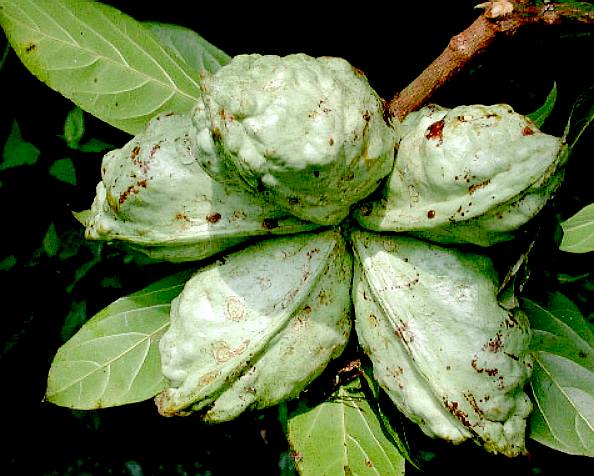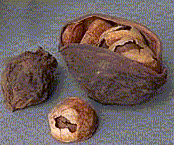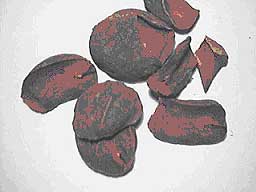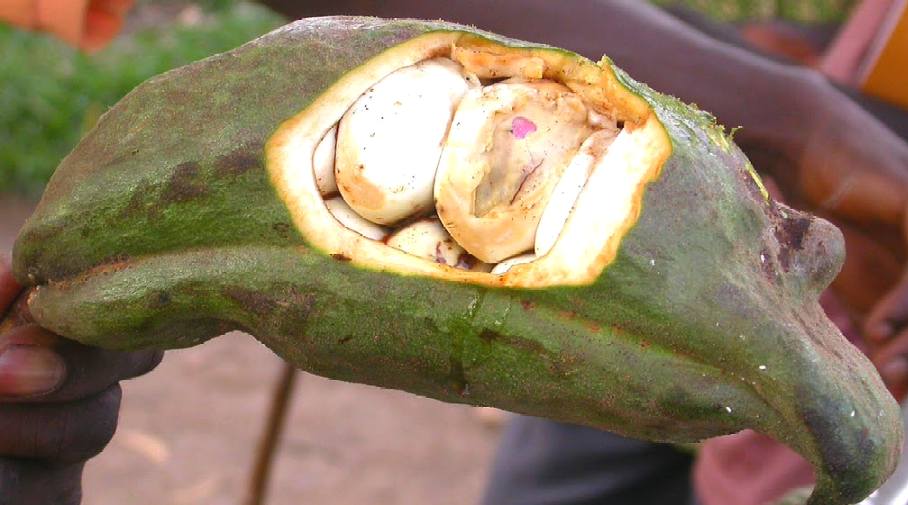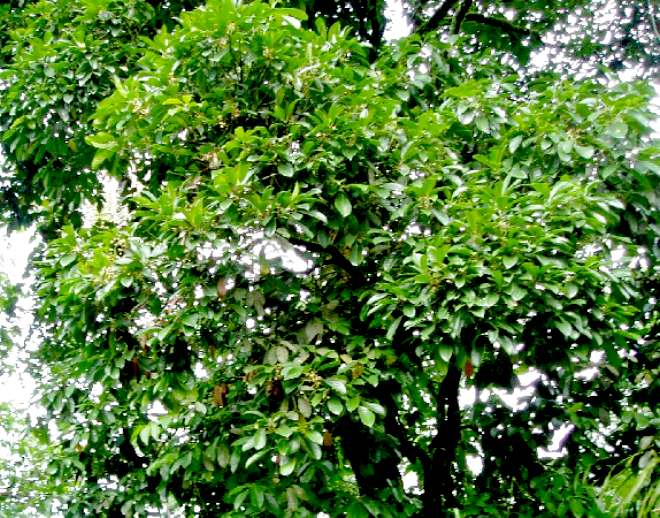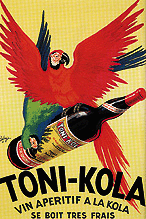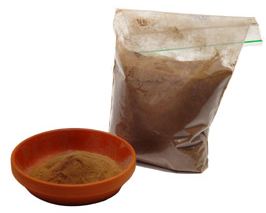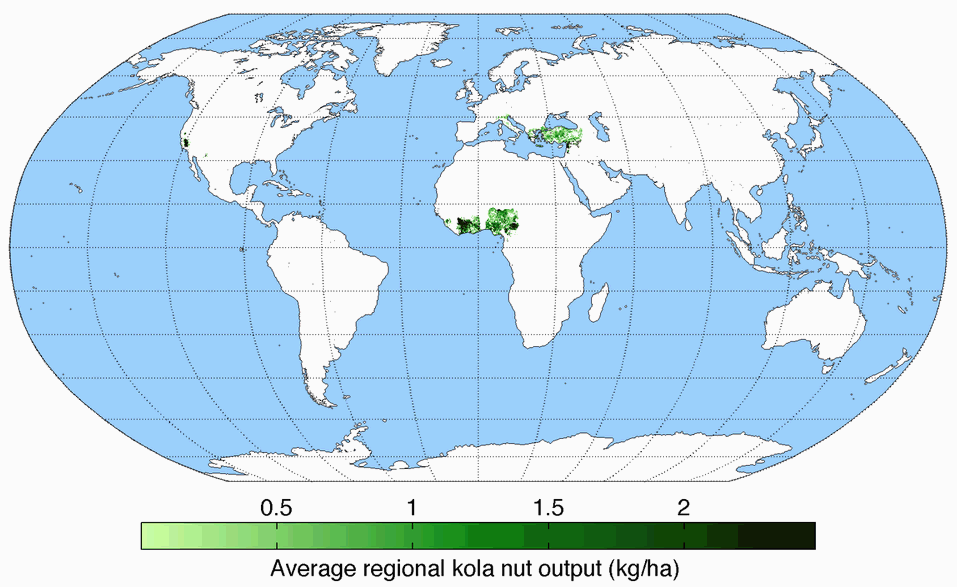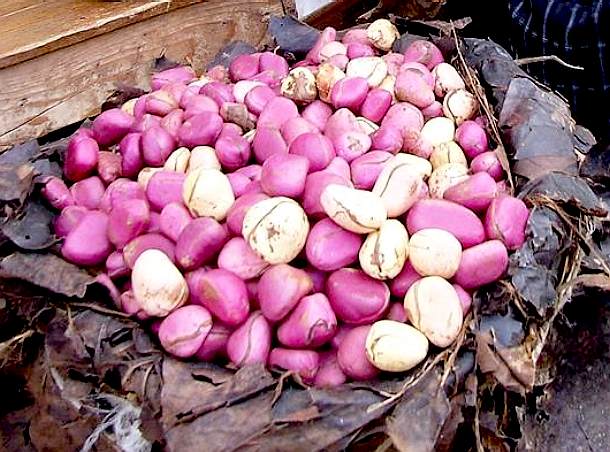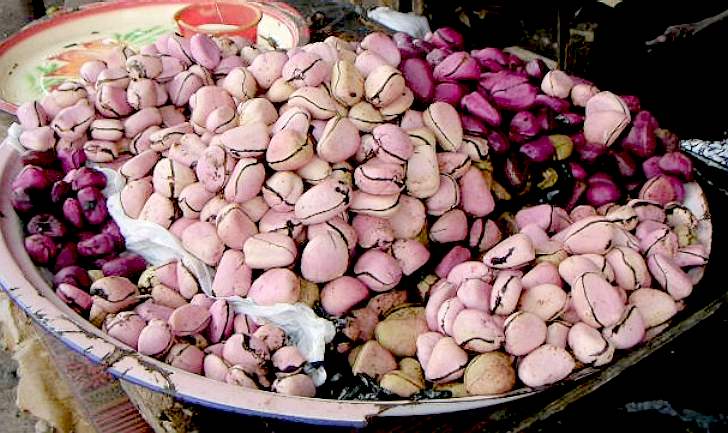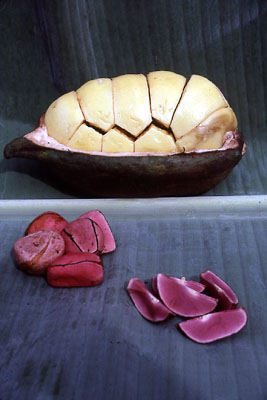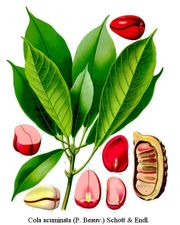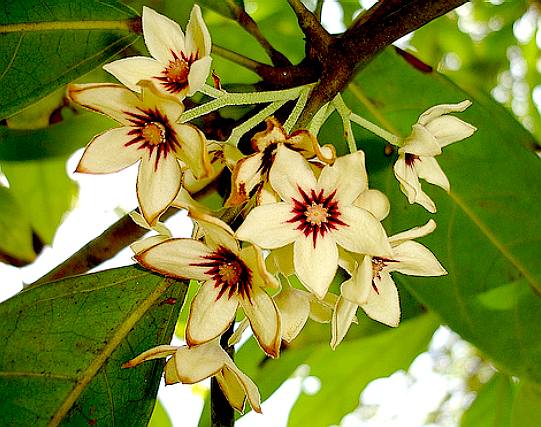|
KOLA NUTS
|
|||||||||||||||||
|
The kola nut has a bitter flavor and contains caffeine. It is chewed in many West African cultures, individually or in a group setting. It is often used ceremonially, presented to chiefs or presented to guests.
INTRODUCTION
Kola nuts (or cola nuts) are the seed pods of various evergreen trees; Sterculiaceae cola vera is the scientific name of the most common species. The kola nut trees, which grow as tall as 60 feet (18 meters), are most common in Western Africa and the Atlantic coast area of Central Africa.
Cola nut pods, dried and fresh
Kola nuts are important in many African societies, particularly in Western Africa. Besides the fact that Kola nuts contain caffeine and act as a stimulant and anti-depressant, they are also thought to reduce fatigue and hunger, aid digestion, and work as an aphrodisiac. In some parts of Africa, kola nuts are given as gifts to visitors entering a home, usually with some formal ceremony. Offering the kola nut is a gesture of friendship and hospitality.
The kola nut ceremony is similar to the traditional American Indian peace pipe or breaking bread in a religious context. Elsewhere, before a marriage, a bag of kola nuts are often given by a groom to the parents of the bride. Kola nuts are a used in rituals performed by religious healers. Besides the ceremonial uses, many Africans consume kola nuts regularly, even daily, for the medicial effects described above. Kola nuts are a common sight in African markets in cities and villages. They are often sold by street vendors at bus and train depots. On a train or bus, a traveler with a kola nut will often offer a piece to the others nearby, whether he knows them or not.
Cola nut trees in Africa and Malaysia
Kola nuts are consumed by breaking them open and into pieces, then chewing the kola nut pieces as one chews gum. Most people find the taste very bitter, especially at first. Sometimes a knife is needed to cut the nut into pieces. The stimulative effect is similar to a strong cup of coffee. Kola nuts are produced commercially in the African and American tropics. In their raw form they are rather hard to find outside the tropics, though some specialty/import grocery stores might sell them.
Kola nuts are best known outside of Africa as an ingredient in cola beverages. There is some evidence that the first kola (or cola) beverage was made by Western Africans who mixed water with dried or fermented kola nuts. Today, homemade cola drinks are very rare in Africa, though store-bought cola drinks are very popular. (Besides water, the most popular drinks throughout Africa are bottled soft drinks and beer.) Commercially produced cola drinks were developed in the late 1800s, when chemists and inventors the world over used kola nuts (as well as other exotic ingredients) in various drinks and tonics. The most famous of these is Coca-Cola, which has become a truly global beverage. More recently, kola nuts and kola nut extract have become popular in Europe and North America as a natural or alternative medicine.
COCA COLA FORMULA
The primary ingredients of Coca-Cola syrup include either high fructose corn syrup or sucrose derived from cane sugar, caramel color, caffeine, phosphoric acid, coca extract, lime extract, vanilla, and glycerin. High fructose corn syrup or sucrose are overwhelmingly the major added ingredients: one 600 ml bottle (≈20.29 U.S. fl. oz.) of Coca Cola contains the approximate equivalent of 15 teaspoons of sugar. However, contrary to what is implied by the "cola" name, Coca-Cola syrup does not contain any kola nut extract. Since no kola extracts are present in the recipe, the primary taste of Coca-Cola comes from
vanilla and cinnamon with trace amounts of
orange, lime and lemon and spices such as
nutmeg.
What was that?
Circa 1990, Eddy L. Harris traveled solo across Africa, from Tunisia to South Africa. He recorded his thoughts and impressions in Native Stranger: A Black American's Journey into the Heart of Africa (New York: Simon & Schuster, 1992). In this excerpt, traveling in a truck in Guinea, he tries kola nut for the first time.
In the back of the truck, someone offered me a little purple piece of something. It was shaped like garlic but looked like a radish. He cut it in half and gave a bit to me, popped the rest in his mouth. I did the same. And oh my God! what a horrid taste. It was like a jolt of lightning, the essence of bitterness.
My body shuddered head to toe. We were so crowded in the back of the truck that the man next to me felt the violence of my shuddering and, by the way he looked at me, he must have thought that I was having some kind of seizure. There was no place to spit out this thing I was eating and I had to keep it in my mouth until finally I chewed it up and swallowed it. I thought to myself: I've got to stop putting strange things in my mouth. At least until I know what they are.
The Congo Cookbook » Sitemap » Akara
Cola nut powder
Cola nut trees have been important in Africa for centuries. Africans used the pods to ease labor pains; seeds to relieve diarrhea, nausea, and hangover. They chewed the nuts as a stimulant and used the roots to clean teeth and sweeten breath. Friends send nuts as invitations or congratulations.
You feel lively and talkative. Loss of appetite, concentration improves and your body will become highly sensitive.
Botanical Name: Cola nitida
Common Names and Synonyms: Kola, cola
Background:
The cola tree grows 40 to 60 feet high and
is native to the tropical rain forests of West
Africa. The leaves are about 10 inches
long and leathery. Small yellow flowers
produce a brown pod that contains anywhere from
4 to 15 cola nuts. The nut’s aroma is
sweet and rose-like. The first taste is
bitter, but sweetens upon chewing. The nut
can be boiled to extract the cola. Cola nut is a
breath sweetener and contains three times the
caffeine of coffee. The original Coca-Cola
contained cola leaf extracts (a source of
cocaine prohibited in soft drinks in the U.S.
after 1904.) Cola is a stimulant to the central
nervous system, it is anti-depressive, and
diuretic.
EFFECTS :
DURATION :
Dosage and preparation
Cola nuts are exported all over the world, from hot producing countries, to just about all other countries. Usually, the kola nuts will have been treated so that a rich extract is supplied.
Botanical aspects
Phytochemistry
Xanthine
Table 1.10: Methylxanthine derivatives
Pharmacology
(1) They inhibit phosphodiesterase, (2) they block (P-1) adenosine receptors (A1 and A2A) and (3) they cause the release of Ca2+ from the storage vesicles into the cytoplasma.
Inhibition of phosphodiesterase will result in an increased cAMP 2nd messenger activity. Blockage of the adenosine receptors causes stimulation and the interference with Ca 2+ -ionchannel activities causes contraction of the smooth- and skeleton muscles.
MODIFIERS :
References
SOLAR COLA
SOLAR COLA LTD - This company is not looking for distributors at this time (2015), but may seek overseas partners as and when the time is ripe. Solar Cola uses the extract of real kola nuts in its formulation.
According to ResearchandMarkets.com the UK drinks market is worth an estimated £53.5 billion, representing a 7% share of total consumer spending. The global soft drinks market is roughly the same percentage of total consumer spending for developed countries.
Prospective investors should consult their own independent investment advisers, and please note this information is provided for general guidance only. It is not a prospectus, but is provided in response to the number of requests we have received asking for more information
For all trade enquiries please contact: The IP Manager at:
Solar Cola UK or Solar Cola Exports Solar House, Herstmonceux, BN27 1RF United Kingdom
+ 44 (0) 1323 831727
Cola mentions in the Cayce Readings
Cola syrup was mentioned in 62 readings, usually as a medicinal purifier of the kidneys. Typically the cola syrup was to be taken with plain water, not carbonated as with the modern day soft drink. See the extracts below :-
257-167 (A) Cola for the body is a stimulant, and will aid at times and deter at others. Taken when tired, very good; but do not gulp - drink slowly.
2084-3 - (A) Generally, Cola is not harmful; but some others might be harmful. If the drink is prepared with the syrup added to plain and not carbonated water, it would be more beneficial.
487-22 - Drink plenty of water during the day. Milk, ice cream or the like is very good. When drinks are taken, let such as these be rather as an extra drink and not too regularly.
2853-1 - A drink made Kola syrup will be helpful to the kidneys for purification, owing to the forms of combinations in same, this should be made with plain and not carbonated waters. 3081-1 - The only soft drink to be taken would be a Cola. This is helpful in the condition through the kidneys, and in the circulation between liver and kidneys. 3109-1 - Here we find that a Cola drink will be good to purify the circulation between the kidneys and the liver, used in plain water. The effect of the tannic forces will be helpful for this condition. Two to three ounces will suffice three to four times a week.
5097-1 - Take cola syrup occasionally as a drink for the activity of the kidneys, but do not take it with carbonated water. Take about 1/2 oz. or 1 oz. of the syrup and add plain water. This to be taken about every other day with or without ice. This will aid in purifying the kidney activity and bladder and will be better for the body.
KOLA NUT SUPPLIERS
SAN BELAU GLOBAL COMPANY
DYNAMIC
MIKOSI INTERNATIONAL LTD Email: kmike2002@yahoo.com
KOLA NUT LINKS
https://en.wikipedia.org/wiki/Coca-Cola_formula http://www.britannica.com/topic/kola-nut https://en.wikipedia.org/wiki/Kola_nut
A taste for adventure capitalists
Solar Cola - a healthier alternative
|
|||||||||||||||||
|
This website is Copyright © 1999 & 2015 Max Energy Limited, an environmental educational charity working hard for world peace. The names Solar Navigator™ and Utopia Tristar™ are trademarks. All other trademarks are hereby acknowledged.
|
